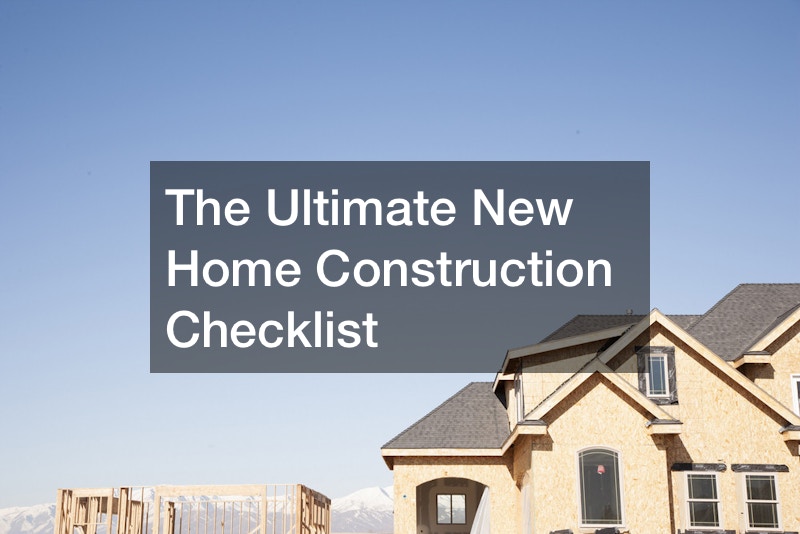
The Home Construction Process
The home building process can be broken down into several distinct steps. First, you will need to plan and design your dream home, taking into account the size of your property and any other factors that may affect its construction. Once this is done, it’s time to get financing for the project – this will typically involve getting a loan from a bank or private lender as well as securing permits from local authorities. Next comes the actual construction phase where materials are procured and foundations laid before walls can be erected and plumbing installed according to specifications. Finally, once all these steps are complete then interior work such as painting, installation of fixtures, and finishes can begin prior to move-in day!
It’s important that during each stage of the building process careful consideration is given in order for everything to run smoothly. For instance when selecting materials you should make sure they meet both safety standards as well as being appropriate for their intended use; likewise with electrical wiring it must adhere strictly to regulations in order to ensure no problems arise after completion. Additionally hiring experienced contractors who have worked on similar projects before is essential for successful results so do some research beforehand if possible!
Designing Your New Home

Designing your new home is an exciting part of the construction process as you get to choose all of the details that will make it unique and reflect your personal style. First, consider how much space you need for each room – whether or not you have a large family might determine if multiple bedrooms are necessary, for example. Then look into different layouts; do you want an open plan living area or separate rooms? Once this decision has been made, think about which materials will be used both inside and out; from flooring to ceiling materials, these choices can drastically change the feel of a space.
Next comes decorating – picking furniture pieces such as sofas and tables that suit your lifestyle while also bringing together colors in fabrics and wallpapers that create harmony within the house. Additionally, making sure there’s enough natural light coming in is important when designing a pleasant atmosphere so take into account window placement accordingly. And finally don’t forget about any extras such as storage solutions – these may seem like small details but they can really enhance the overall design!
Financing Your New Home Construction
Financing your new home construction is an important step that requires careful consideration and planning. The key to successful financing is to understand the different options available, including traditional mortgage loans from banks or private lenders as well as government-backed loan programs such as FHA and VA loans for those who qualify. It’s also possible to get a short-term loan specifically designed for construction purposes which can provide bridge financing until more permanent long-term funding is secured. Additionally, cash reserves may be required upfront in order to cover any unforeseen costs during the project so it’s important to factor this into budgeting plans when setting out on your building journey.
When looking at potential lenders, make sure you compare interest rates, closing costs and repayment terms in order to find the best deal for your situation – these details will vary from lender to lender so shop around before making a decision. Be aware of any hidden fees associated with each type of loan offer too – these can add up quickly over time and end up costing more than anticipated if not taken into account! Finally consider working with a financial advisor who can help guide you through every step of the process; they will be able to answer any questions while ensuring that all paperwork needed is filled out correctly and submitted on time so there are no delays or issues down the line.
Making the decision to build a new home is both exciting and daunting. With the right planning and design, combined with educating yourself on the process of construction excavation, home building process and financing your new home construction can have you in your dream of a newly constructed house sooner than you think. Taking into account all aspects of the project will lead to success before breaking ground on your dream project ever happens. With proper organization, planning and design anyone can construct a beautiful new home that fits their vision.
Moving Out

If you’re planning to build a new home, chances are you’re also planning to move out of your current residence. This means it’s time to start packing up all of your belongings and getting ready for the big move. Moving can be a stressful and time-consuming process, so it’s important to give yourself plenty of time to get everything organized. Start by creating a packing schedule, and be sure to set aside enough boxes and other supplies to get the job done. As you pack, be sure to label all of your boxes with their contents and the room they should go in, as this will make unpacking much easier once you’re in your new home.
In addition to packing, you’ll also want to take care of any necessary repairs or renovations to your current home before you leave. This could include things like fixing any broken windows or appliances, or touching up any areas of the home that have been damaged. You’ll also want to clean the home thoroughly to ensure it is in good condition for the next occupants. Depending on the terms of your lease or mortgage, you may be required to leave the home in a certain condition when you move out. Be sure to familiarize yourself with these requirements to avoid any issues.
Choosing to Build
Before you can start building your new home, you’ll need to decide whether you want to build from scratch or purchase a pre-existing home that you can renovate. Building from scratch can be more expensive, but it allows you to have complete control over the design and layout of your home. You’ll be able to choose everything from the floor plan to the materials and finishes, and you can customize the home to meet your specific needs and preferences.
On the other hand, purchasing an existing home can be a more cost-effective option, especially if you’re able to find a property that is in good condition and only requires minor renovations. Renovating an existing home can be a great way to put your own personal touch on a property, and it can also be more environmentally friendly as it reduces the need for new materials and resources. However, be sure to thoroughly inspect the property before you buy to ensure it is structurally sound and in good condition. You’ll also want to consider the location of the property, as well as any potential zoning issues that may affect your ability to make renovations.
Planning and Resources

Once you’ve made the decision to build a new home, it’s time to start planning. This means creating a budget, finding a reputable builder, and obtaining all necessary permits. It’s important to be realistic about your budget and to allocate your funds wisely. You’ll want to consider the cost of materials, labor, and any other expenses that may come up during the building process. You’ll also want to shop around to find the best deals on materials and to negotiate the best price with your builder.
When it comes to finding a builder, it’s important to do your research. Look for a builder with a good reputation and a track record of completing projects on time and within budget. You’ll also want to get references from previous clients and to visit some of the builder’s completed projects to get a sense of their work. Be sure to have a clear contract in place that outlines the terms of the project, including the timeline, payment schedule, and any warranties or guarantees.
In addition to hiring a builder, you’ll also need to obtain any necessary permits and approvals from local authorities. This may include things like building permits, zoning permits, and any other approvals that are required for your specific project. Be sure to familiarize yourself with the local building codes and regulations, as these will be crucial.
Independence and Contacts
This is a crucial part of the ultimate new home construction checklist. Building a new home is a major undertaking, and it’s important to have the right support system in place. This includes hiring a reputable home building construction company and any other necessary contractors, such as electricians or plumbers. Be sure to research these professionals carefully and get references before hiring anyone. It’s also a good idea to have a lawyer or real estate agent on hand to help you navigate any legal or financial issues that may arise during the building process.
Preparing the Land

This is a crucial part of the ultimate new home construction checklist. Before construction can begin, you’ll need to prepare the land for building. This may involve clearing the land of any trees or debris with the help of land clearing services, grading the site to ensure proper drainage, and installing any necessary utilities such as water and electricity. You’ll also need to obtain any necessary permits and approvals from local authorities.
Furnishings
This is a crucial part of the ultimate new home construction checklist. While your new home is being built, it’s a good idea to start thinking about the furnishings and decorations you’ll need once you move in. This includes everything from furniture and used appliances to lighting and window treatments. Be sure to create a budget for these items and start shopping around early to ensure you have everything you need when your home is completed.
In the Meantime
This is a crucial part of the ultimate new home construction checklist. During the construction process, you’ll need to find somewhere to live in the meantime. This may mean renting a temporary residence or staying with friends or family. If you need to store any of your belongings during this time, you may want to consider using self-storage units. Be sure to make arrangements in advance to ensure you have a place to stay while your new home is being built.
Creating a Timeline
This is a crucial part of the ultimate new home construction checklist. To ensure that your new home is completed on time and within budget, it’s important to create a timeline for the construction process. This should include milestones for each stage of the process, as well as any deadlines for materials or inspections. Be sure to communicate this timeline to your builder and any other contractors to ensure everyone is on track.
Moving Day
This is a crucial part of the ultimate new home construction checklist. You might need a used truck for sale to help, or you might use a cargo van rental. After months of planning and hard work, it’s finally time to move into your new home. If you need help with the move, you may want to consider hiring a local moving company and renting a cargo van for the day. Be sure to coordinate with your builder and any other contractors to ensure that all final touches are completed before you move in. This includes things like painting, installing flooring, and hooking up utilities.
Finishing Touches
This is a crucial part of the ultimate new home construction checklist. Once you’ve moved into your new home, it’s time to add the finishing touches. This may include things like hanging curtains and more. Be sure to take your time and make sure everything is just the way you want it before fully settling into your new home. If you’re looking to sell your home in the future, you may want to consider investing in some lawn and garden care to increase curb appeal. Additionally, if you’re in the market for a new home, you may want to keep an eye out for houses for sale in your area.



